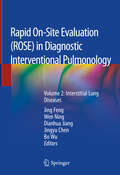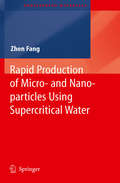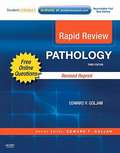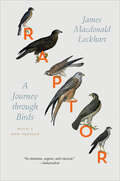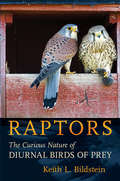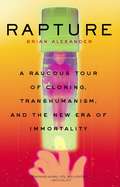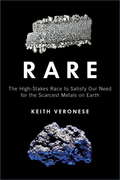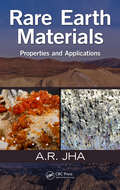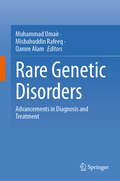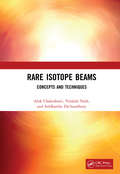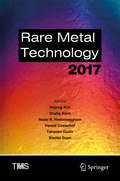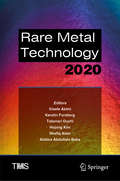- Table View
- List View
Rapid On-Site Evaluation (ROSE) in Diagnostic Interventional Pulmonology: Volume 2: Interstitial Lung Diseases
by Bo Wu Jing Feng Wen Ning Dianhua Jiang Jingyu ChenThis book demonstrates the recent advances in rapid on-site evaluation (ROSE) for differential diagnosis of interstitial lung disease (ILD). Interstitial lung disease is a group of diffuse parenchymal lung disorders affecting the interstitium, a part of the lung's anatomic structure, causing inflammation, scarring, or excess fluid. ILDs include interstitial pneumonia, idiopathic pulmonary fibrosis, nonspecific interstitial pneumonitis, cryptogenic organizing pneumonia and sarcoidosis, which are associated with various degrees of morbidity and mortality rates. ROSE has proven its value in diagnosis with routine transbronchial lung biopsy (TBLB) procedures, especially in difficult clinical cases. The first part of the book discusses the principals of performing ROSE procedures, reviews the basic concepts and summarizes the distribution and morphology of tracheal/ bronchial/ pulmonary cells. The second part covers specific interstitial disorders, including a number of difficult and rare cases, and features iCT images and cytological illustrations. Providing readers with valuable insights, the book is an important resource for practitioners involved in the care and treatment of patients with ILD. This book is part of the 4-volume collection ROSE in Diagnostic Interventional Pulmonology.
Rapid Production of Micro- and Nano-particles Using Supercritical Water
by Zhen FangThis book shows how to use supercritical water (SCW) to synthesize nano- and micro- oxides, inorganic salts and metal particles and its recent advancement. Also polymer/biomass particles can be produced by using the method of precipitation of solutes from SCW. The particles can be used as catalysts for biomass conversions, materials in ceramics & electronic devices and composite materials. Particles are easily produced continuously in a flow reactor in short and long reaction times. Besides the synthesis process, the book also present studies of the properties of these materials. The size, size distribution, crystal growth & structure, and morphology of particles produced by supercritical water can be controlled by the feed concentrations, pH, pressures, temperatures, heating & cooling rates, organic modifications, reducing or oxidizing atmospheres, flow rates and reaction times.
Rapid Refrigeration and Water Protection: Next Generation Adsorbents (Springer Water)
by Rasel Das Bidyut Baran SahaThis book provides a cross-disciplinary, multi-scale assessment of the development of adsorption-based refrigerants and super-adsorbent-based wastewater purification. The book covers two major aspects from the 21st century, including the development of an environmentally benign adsorption cooling system and the preparation of a super-adsorbent for water purification. Although work has been published on these topics, the authors present the latest findings and introduce some new perspectives. The book is written as a reference book with contributions from global field experts and will appeal to water engineers, chemists, environmentalists, physicists, material scientists, nano-technologists, and environmental technologists.
Rapid Review Pathology (Third Edition)
by Edward F. Goljan(Revised reprint) This book focuses on key concepts in pathology and covers important disorders of all the vital systems in the human body.
Rapid Review of Chemistry for the Life Sciences and Engineering: With Select Applications
by Armen S. Casparian Gergely Sirokman Ann OmolloTo understand, maintain, and protect the physical environment, a basic understanding of chemistry, biology, and physics, and their hybrids is useful. Rapid Review of Chemistry for the Life Sciences and Engineering demystifies chemistry for the non-chemist who, nevertheless, may be a practitioner of some area of science or engineering requiring or involving chemistry. It provides quick and easy access to fundamental chemical principles, quantitative relationships, and formulas. Armed with select, contemporary applications, it is written in the hope to bridge a gap between chemists and non-chemists, so that they may communicate with and understand each other. Chapters 1–10 are designed to contain the standard material in an introductory college chemistry course. Chapters 11–15 present applications of chemistry that should interest and appeal to scientists and engineers engaged in a variety of fields. Additional features More than 100 solved examples clearly illustrated and explained with SI units and conversion to other units using conversion tables included Assists the reader to understand organic and inorganic compounds along with their structures, including isomers, enantiomers, and congeners of organic compounds Provides a quick and easy access to basic chemical concepts and specific examples of solved problems This concise, user-friendly review of general and organic chemistry with environmental applications will be of interest to all disciplines and backgrounds.
Rapid Review of Radiology (Medical Rapid Review Ser.)
by Shahid Hussain Sherif Aaron Latif Adrian David HallAs in all specialties, learning in radiology is a life long process but for radiologists in training there is a vast amount of information to assimilate. In this book the authors have compiled 191 cases to help the reader with the practical aspects of image recognition and differential diagnosis.The selection of cases is broad enough to provide an
Rapt: Attention And The Focused Life
by Winifred GallagherAcclaimed behavioral science writer Gallagher makes the radical argument that the quality of a life largely depends on what and how one chooses to pay attention. "Rapt" yields fresh insights into the nature of reality and what it means to be fully alive.
Raptor: A Journey through Birds
by James Macdonald LockhartFrom the merlin to the golden eagle, the goshawk to the honey buzzard, James Macdonald Lockhart’s stunning debut is a quest of beak, talon, wing, and sky. On its surface, Raptor is a journey across the British Isles in search of fifteen species of birds of prey, but as Lockhart seeks out these elusive predators, his quest becomes so much more: an incomparably elegant elegy on the beauty of the British landscape and, through the birds, a journey toward understanding an awesome power at the heart of the natural world—a power that is majestic and frightening in its strength, but also fragile. Taking as his guide the nineteenth-century Scottish naturalist and artist William MacGillivray, Lockhart loosely follows the historical trail forged by MacGillivray as he ventured from Aberdeen to London filling his pockets with plants and writing and illustrating the canonical A History of British Birds. Linking his journey to that of his muse, Lockhart shares his own encounters with raptors ranging from the scarce osprey to the successfully reintroduced red kite, a species once protected by medieval royal statute, revealing with poetic immediacy the extraordinary behaviors of these birds and the extreme environments they call home. Creatures both worshipped and reviled, raptors have a talon-hold on the human heart and imagination. With his book, Lockhart unravels these complicated ties in a work by turns reverent and euphoric—an interweaving of history, travel, and nature writing at its best. A hymn to wanderers, to the land and to the sky, and especially to the birds, Raptor soars.
Raptors of New Mexico
by Jean-Luc E. CartronNo book has ever before specifically focused on the birds of prey of New Mexico. Both Florence Bailey (1928) and J. Stokley Ligon (1961) published volumes on the birds of New Mexico, but their coverage of raptors was somewhat limited. In the ensuing years a great deal of new information has been collected on these mighty hunters' distribution, ecology, and conservation, including in New Mexico.The book begins with a history of the word "raptor." The order of Raptatores, or Raptores, was first used to classify birds of prey in the early nineteenth century, derived from the Latin word raptor, one who seizes by force. The text then includes the writings of thirty-seven contributing authors who relate their observations on these regal species.For example, Joe Truett recounts the following in the chapter on the Swainson's Hawk:"From spring to fall each year at the Jornada Caves in the Jornada del Muerto, Swainson's hawks assemble daily to catch bats. The bats exit the caves--actually lava tubes--near sundown. The hawks swoop in, snatch bats from the air, and eat them on the wing."Originally from France, Jean-Luc Cartron has lived and worked on several continents, finding his passion in the wide-open spaces of New Mexico. He became fascinated by the birds of prey and has studied their ecology and conservation for nearly twenty years.Raptors of New Mexico will provide readers with a comprehensive treatment of all hawks, eagles, kites, vultures, falcons, and owls breeding or wintering in New Mexico, or simply migrating through the state. This landmark study is also beautifully illustrated with more than six hundred photographs, including the work of more than one hundred photographers, and more than twenty species distribution maps.
Raptors: The Curious Nature of Diurnal Birds of Prey (Birdlife Conservation Ser. #Volume 9)
by Keith L. BildsteinRaptors are formally classified into five families and include birds—such as eagles, ospreys, kites, true hawks, buzzards, harriers, vultures, and falcons—that are familiar and recognized by many observers. These diurnal birds of prey are found on every continent except Antarctica and can thrive in seemingly inhospitable spots such as deserts and the tundra. They have powerful talons and hooked beaks for cutting and tearing meat, and keen binocular vision to aid in their hunting prowess. Because of their large size, distinctive feeding habits, and long-distance flight patterns, raptors intrigue humans and have been the subject of much general interest as well as extensive scientific research.Keith L. Bildstein has watched and studied raptors on five continents and is well prepared to explain their critical importance, not only as ecological entities but also as inspirational tokens across natural and human-dominated landscapes. His book offers a comprehensive and accessible account of raptors, including their evolutionary history, their relationships to other groups of birds, their sensory abilities, their general natural history, their breeding ecology and feeding behavior, and threats to their survival in a human-dominated world. Biologically sound but readable, Raptors is a nontechnical overview of this captivating group. It will allow naturalists, birders, hawk-watchers, science educators, schoolchildren, and the general public, along with new students in the field of raptor biology, to understand and appreciate these birds, and in so doing better protect them.
Rapture
by Brian AlexanderIn Rapture, Brian Alexander takes readers into the surprising stories behind cloning, stem cells, miracle drugs, and genetic engineering to show how the battle for the human soul is playing out in the broader culture-and how the outcome will affect us all. Rapture's Dickensian cast of characters includes the father of regenerative medicine, an anti-aging guru, and a former fundamentalist Christian and founder of the company that reportedly cloned the first human cell. This motley crew is in part being united by the force of the opposition: a burgeoning bio-Luddite movement whose foot soldiers-a strange coalition of conservative Republicans, the Christian right, and the Greens-predict impending doom should we become adherents of the new bio-utopian faith. Sometimes irreverent, sometimes shocking, always entertaining, Rapture shows how the biotech agenda has come to be seen as both salvation and heresy, how we have gotten this far already, and why we'll go where nobody thought we could.
Rapture
by Brian AlexanderIn Rapture, Brian Alexander takes readers into the surprising stories behind cloning, stem cells, miracle drugs, and genetic engineering to show how the battle for the human soul is playing out in the broader culture-and how the outcome will affect us all. Rapture's Dickensian cast of characters includes the father of regenerative medicine, an anti-aging guru, and a former fundamentalist Christian and founder of the company that reportedly cloned the first human cell. This motley crew is in part being united by the force of the opposition: a burgeoning bio-Luddite movement whose foot soldiers-a strange coalition of conservative Republicans, the Christian right, and the Greens-predict impending doom should we become adherents of the new bio-utopian faith. Sometimes irreverent, sometimes shocking, always entertaining, Rapture shows how the biotech agenda has come to be seen as both salvation and heresy, how we have gotten this far already, and why we'll go where nobody thought we could.
Rapture for the Geeks: When AI Outsmarts IQ
by Richard DoolingWill the Geeks inherit the earth? If computers become twice as fast and twice as capable every two years, how long is it before they're as intelligent as humans? More intelligent? And then in two more years, twice as intelligent? How long before you won't be able to tell if you are texting a person or an especially ingenious chatterbot program designed to simulate intelligent human conversation? According to Richard Dooling in Rapture for the Geeks--maybe not that long. It took humans millions of years to develop opposable thumbs (which we now use to build computers), but computers go from megabytes to gigabytes in five years; from the invention of the PC to the Internet in less than fifteen. At the accelerating rate of technological development, AI should surpass IQ in the next seven to thirty-seven years (depending on who you ask). We are sluggish biological sorcerers, but we've managed to create whiz-bang machines that are evolving much faster than we are. In this fascinating, entertaining, and illuminating book, Dooling looks at what some of the greatest minds have to say about our role in a future in which technology rapidly leaves us in the dust. As Dooling writes, comparing human evolution to technological evolution is "worse than apples and oranges: It's appliances versus orangutans. " Is the era of Singularity, when machines outthink humans, almost upon us? Will we be enslaved by our supercomputer overlords, as many a sci-fi writer has wondered? Or will humans live lives of leisure with computers doing all the heavy lifting? With antic wit, fearless prescience, and common sense, Dooling provocatively examines nothing less than what it means to be human in what he playfully calls the age of b. s. (before Singularity)--and what life will be like when we are no longer alone with Mother Nature at Darwin's card table. Are computers thinking and feeling if they can mimic human speech and emotions? Does processing capability equal consciousness? What happens to our quaint beliefs about God when we're all worshipping technology? What if the human compulsion to create ever more capable machines ultimately leads to our own extinction? Will human ingenuity and faith ultimately prevail over our technological obsessions? Dooling hopes so, and his cautionary glimpses into the future are the best medicine to restore our humanity.
Rare
by Keith VeroneseHow will your life change when the supply of tantalum dries up? You may have never heard of this unusual metal, but without it smartphones would be instantly less omniscient, video game systems would falter, and laptops fail. Tantalum is not alone. Rhodium. Osmium. Niobium. Such refugees from the bottom of the periodic table are key components of many consumer products like cell phones, hybrid car batteries, and flat screen televisions, as well as sophisticated medical devices and even weapon systems. Their versatile properties have led manufacturers to seek these elements out to maximize longevity, value, and efficiency, but not without a human price. In addition to explaining the chemistry behind rare earth metals, Rare delves into the economic and geopolitical issues surrounding these "conflict minerals," blending tales of financial and political struggles with glimpses into the human lives that are shattered by the race to secure them. In the past decade, the Congo has been ravaged by tribal wars fought to obtain control of tantalum, tungsten, and tin supplies in the region, with over five million people dying at the crossroads of supply and demand. A burgeoning black market in China, Africa, and India is propped up by school-age children retrieving and purifying these metals while risking their lives and health in the process. Fears of future political struggles inside China, the world's largest supplier of these metals, have already sent the United States, Great Britain, and Japan racing to find alternative sources.Will scientists be able to create lab substitutes for some or all of these metals? Will Afghanistan be the next big supplier of rare metals? What happens when the limited supply runs out? Whatever the answers, it is clear that our modern lifestyle, dependent on technology, is far from stable.From the Hardcover edition.
Rare Conditions, Diagnostic Challenges, and Controversies in Clinical Neuropsychology: Out of the Ordinary
by Barbara A. Wilson Shai Betteridge Jessica FishThis book highlights those rare, difficult to diagnose or controversial cases in contemporary clinical neuropsychology. The evidence base relevant to this type of work is almost by definition insufficient to guide practice, but most clinicians will encounter such cases at some point in their careers. By documenting the experiences and learning of clinicians who have worked with cases that are ‘out of the ordinary’, the book addresses an important gap in the literature. The book discusses 23 challenging and fascinating cases that fall outside what can be considered routine practice. Divided into three sections, the text begins by addressing rare and unusual conditions, defined as either conditions with a low incidence, or cases with an atypical presentation of a condition. It goes on to examine circumstances where an accurate diagnosis and/or coherent case formulation has been difficult to reach. The final section addresses controversial conditions in neuropsychology, including those where there is ongoing scientific debate, disagreement between important stakeholders, or an associated high-stakes decision. This text covers practice across lifespan and offers crucial information on specific conditions as well as implications for practice in rare disorders. This book will be beneficial for clinical neuropsychologists and applied psychologists working with people with complex neurological conditions, along with individuals from medical, nursing, allied health and social work backgrounds. It will further be of appeal to educators, researchers and students of these professions and disciplines.
Rare Earth Materials: Properties and Applications
by A.R. JhaRecent studies indicate that China accounts for about 96 percent of the world's supply of rare earth materials (REMs). With REMs becoming increasingly important for a growing number of high-tech applications, appropriate action must be taken to mitigate the effects of a shortage of critical REMs in defense systems and components.Bringing together i
Rare Earths-Transition Metals-Boron Compounds: Basic Properties to Technical Applications
by Emil BurzoThis book presents advances in the field of rare-earth (R) – transition metal (M) – boron compounds with extensive references. Since titanium and scandium do not form compounds with rare-earths, the Sc/Ti-M-B series are additionally presented. In each chapter the crystal structures, the complex physical properties as determined from neutron diffraction, magnetic measurements, resonance studies, transport properties and band structure calculations are critical analyzed. The models used in describing the experimental evidence are also presented. Tables with the main properties of the R-M-B compounds are given and representative data are illustrated in figures. In this way, the book provides state-of-the art knowledge and a valuable analysis of up-to-date results in the field. The technical applications, as permanent magnets, thermoelectric and magnetocaloric devices, hydrogen storage are also highlighted along with the authors insights into future directions in the field. The book is of interest for scientists involved in the development of the field as well as those working in the technical uses of rare-earth compounds.
Rare Genetic Disorders: Advancements in Diagnosis and Treatment
by Muhammad Umair Misbahuddin Rafeeq Qamre AlamThis book introduces different Rare Genetic Disorders (RGDs), and challenges in their diagnosis. The chapters of the book discuss the emerging research and clinical approaches for the diagnosis of rare genetic disorders. It further reviews the future of genetic therapies for the treatment of rare genetic diseases and examine the recent advancements in the field of genetic testing for the diagnosis of these diseases. The book also covers the role of variants in the genome (genetic modifiers) that alleviate (suppress) or exacerbate (enhance) the severity of the disease, resulting in the variability of phenotypic outcomes. Further, the book examines different animal models for critical understanding of disease mechanisms, and the opportunity to evaluate the effect of therapeutic compounds in pre-clinical studies. The subsequent chapters present the state-of-the-art drug discovery strategies and biological approaches for the treatment of rare genetic disorders. Towards the end, the book reviews the current challenges in the diagnosis and treatment of the patients of rare genetic disorders and future opportunities. This book is useful for clinical geneticists, molecular and biochemical geneticists, researchers working in gene therapy and genome editing.
Rare Isotope Beams: Concepts and Techniques
by Alok Chakrabarti Vaishali Naik Siddhartha DechoudhuryRare Isotope Beams (RIBs) are ion beams of exotic radioactive nuclei. The study of these nuclei is key to understanding the limits of nuclear existence, nucleo-synthesis in such violent stellar sites as supernovae and merging neutron stars, and the fundamental symmetries of nature. These nuclei also provide a unique probe to study condensed matter and many of them are potentially new radioisotopes for more effective medical diagnostics and therapy. Rare Isotope Beams: Concepts and Techniques gives an up-to-date overview of all these aspects of RIB science in a single volume containing the scientific motivation, production techniques, experimental techniques for studying exotic nuclei, methods used in condensed matter research, and medical applications. The emphasis throughout is on concepts to facilitate understanding of the essence of each topic in this diverse and cross-disciplinary field involving nuclear physics, astrophysics, and particle accelerators. A brief description of major RIB facilities is also presented. Exotic nuclei are difficult to produce in enough numbers and their production involves different nuclear reaction routes and a wide range of advanced technologies, which are presented in a comprehensive manner. Experimental techniques used to study exotic nuclei are provided with examples highlighting the intricate nature of such experiments. Another unique feature is the open-ended nature of the discussions, bringing out the future challenges and possibilities in this evolving field. The book offers an excellent overview of concepts and techniques involved in RIB science for new researchers entering the field as well as professionals.
Rare Metal Technology 2017
by Neale R. Neelameggham Hojong Kim Shafiq Alam Harald Oosterhof Takanari Ouchi Xiaofei GuanThis collection presents papers from a symposium on extraction of rare metals as well as rare extraction processing techniques used in metal production. Topics include the extraction and processing of elements like antimony, arsenic, gold, indium, palladium, platinum, rare earth metals including yttrium and neodymium, titanium, tungsten, and vanadium. Rare processing techniques are covered, including direct extraction processes for rare-earth recovery, biosorption of precious metals, fluorination behavior of uranium and zirconium mixture of fuel debris treatment, and recovery of valuable components of commodity metals such as zinc, nickel, and metals from slag.
Rare Metal Technology 2020 (The Minerals, Metals & Materials Series)
by Hojong Kim Shafiq Alam Takanari Ouchi Gisele Azimi Alafara Abdullahi Baba Kerstin ForsbergThis collection presents papers from a symposium on extraction of rare metals as well as rare extraction processing techniques used in metal production. Rare metals include strategic metals that are in increasing demand and subject to supply risks. Metals represented include neodymium, dysprosium, scandium and others; platinum group metals including platinum, palladium, iridium, and others; battery related metals including lithium, cobalt, nickel, and aluminum; electronics-related materials including copper and gold; and refectory metals including titanium, niobium, zirconium, and hafnium. Other critical materials such as gallium, germanium, indium and silicon are also included. Papers cover various processing techniques, including but not limited to hydrometallurgy (solvent extraction, ion exchange, precipitation, and crystallization), electrometallurgy (electrorefining and electrowinning), pyrometallurgy, and aeriometallurgy (supercritical fluid extraction). Contributions are focused on primary production as well as secondary production through urban mining and recycling to enable a circular economy.A useful resource for all involved in commodity metal production, irrespective of the major metalProvides knowledge of cross-application among industriesExtraction and processing of rare metals that are the main building block of many emerging critical technologies have been receiving significant attention in recent years.The technologies that rely on critical metals are prominent worldwide, and finding a way to extract and supply them effectively is highly desirable and beneficial.
Rare Metal Technology 2021 (The Minerals, Metals & Materials Series)
by Neale R. Neelameggham Hojong Kim Shafiq Alam Takanari Ouchi Gisele Azimi Alafara Abdullahi Baba Kerstin ForsbergThis collection presents papers from a symposium on extraction of rare metals as well as rare extraction processing techniques used in metal production. It covers metals essential for critical modern technologies including electronics, electric motors, generators, energy storage systems, and specialty alloys. Rare metals are the main building blocks of many emerging critical technologies and have been receiving significant attention in recent years. Much research in academia and industry is devoted to finding novel techniques to extract critical and rare metals from primary and secondary sources. The technologies that rely on critical metals are dominating the world, and finding a way to extract and supply them effectively is highly desirable and beneficial. Rapid development of these technologies entails fast advancement of the resource and processing industry for their building materials. Authors from academia and industry exchange knowledge on developing, operating, and advancing extractive and processing technologies. Contributions cover rare-earth elements (magnets, catalysts, phosphors, and others), energy storage materials (lithium, cobalt, vanadium, graphite), alloy elements (scandium, niobium, titanium), and materials for electronics (gallium, germanium, indium, gold, silver). The contributions also cover various processing techniques in mineral beneficiation, hydrometallurgy, separation and purification, pyrometallurgy, electrometallurgy, supercritical fluid extraction, and recycling (batteries, magnets, electrical and electronic equipment).
Rare Metal Technology 2022 (The Minerals, Metals & Materials Series)
by Neale R. Neelameggham Hojong Kim Shafiq Alam Takanari Ouchi Gisele Azimi Alafara Abdullahi Baba Kerstin Forsberg Hong PengThis collection presents papers from a symposium on extraction of rare metals from primary and secondary materials and residues as well as rare extraction processing techniques used in metal production. Authors cover the extraction of less common or minor metals including elements such as antimony, bismuth, barium, beryllium, boron, calcium, chromium, gallium, germanium, hafnium, indium, manganese, molybdenum, platinum group metals, rare earth metals, rhenium, scandium, selenium, sodium, strontium, tantalum, tellurium, and tungsten. Contributions also discuss rare metals of low-tonnage sales compared to high-tonnage metals (iron, copper, nickel, lead, tin, zinc, or light metals such as aluminum, magnesium, or titanium and electronic metalloid silicon). Authors also cover biometallurgy, hydrometallurgy, and electrometallurgy while novel high-temperature processes such as microwave heating, solar-thermal reaction synthesis, and cold crucible synthesis of rare metals are addressed. Also included in this collection is the design of extraction equipment used in these processes from suppliers as well as laboratory and pilot plant studies.
Rare Metal Technology 2023 (The Minerals, Metals & Materials Series)
by Neale R. Neelameggham Hojong Kim Shafiq Alam Takanari Ouchi Gisele Azimi Alafara Abdullahi Baba Kerstin Forsberg Hong Peng Athanasios KaramalidisThis collection presents papers from a symposium on extraction of rare metals from primary and secondary materials and residues as well as rare metals extraction processing techniques used in metal production. The collection covers the extraction of less common or minor metals including elements such as antimony, bismuth, barium, beryllium, boron, calcium, chromium, gallium, germanium, hafnium, indium, manganese, molybdenum, platinum group metals, rare earth metals, rhenium, scandium, selenium, sodium, strontium, tantalum, tellurium, and tungsten. It also includes rare metals of low-tonnage sales compared to high-tonnage metals (iron, copper, nickel, lead, tin, zinc, or light metals such as aluminum, magnesium, or titanium and electronic metalloid silicon). Rare metal processing covers bio-metallurgy, hydro-metallurgy, and electro-metallurgy while novel high-temperature processes such as microwave heating, solar-thermal reaction synthesis, and cold crucible synthesis of rare metals are also addressed. Also included in this collection is the design of extraction equipment used in these processes from suppliers as well as laboratory and pilot plant studies.
Rare and Blue: Finding Nature's Treasures
by Constance Van HovenA variety of rare blue species--from the blue lobster to the blue black bear--are rare and unique for a reason.Travel across Earth to discover eight species that are blue in color and are either naturally rare, threatened, or endangered. Panoramic illustrations and a playful main text prompt a search for the blue species at hand, while the page-turn and informative sidebars zoom in to reveal a closer look at the species. There's a lot to uncover about the Karner blue butterfly, blue black bear, blue whale, Quitobacquito pupfish, Cerulean warbler, blue lobster, Eastern Indigo snake, and big bluestem grass. A surprise ending celebrates that planet Earth is the rarest and bluest and must be protected for the sake of all.
